Modal Characterization of Manual Wheelchairs
Abstract
:1. Introduction
2. Materials and Methods
2.1. Manual Wheelchairs
2.2. Mesh
2.3. Experimental Modal Analysis
3. Results
3.1. Frame
3.2. Side Guards
3.3. Backrest
3.4. Seat
3.5. Footrest
3.6. Rear Wheel
3.7. Handrim
4. Discussion
5. Conclusions
Author Contributions
Funding
Conflicts of Interest
Appendix A
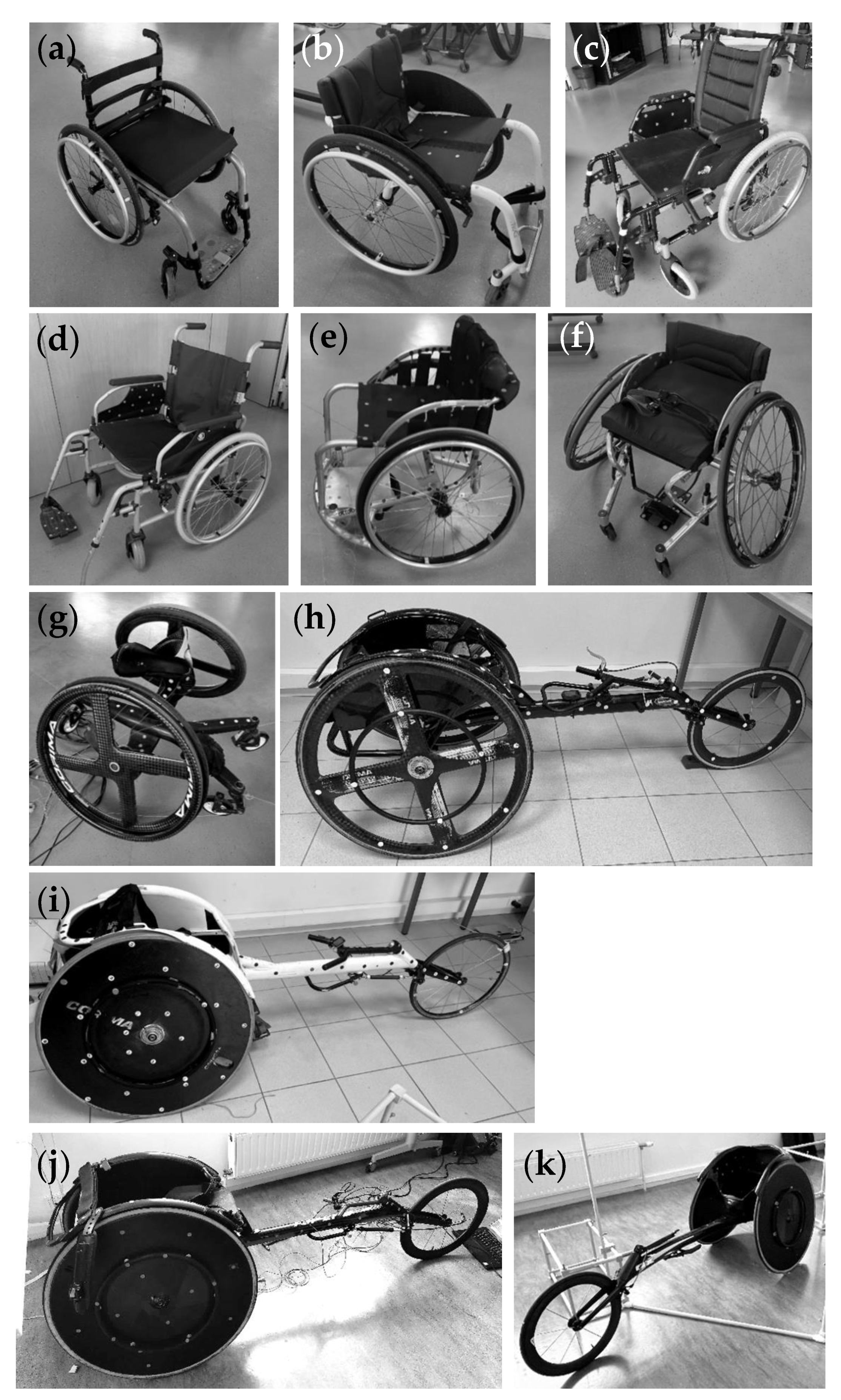
References
- Pope, M.H.; Wilder, D.G.; Magnusson, M.L. A Review of Studies on Seated Whole Body Vibration and Low Back Pain. Proc. Inst. Mech. Eng. H 1999, 213, 435–446. [Google Scholar] [CrossRef] [PubMed]
- Pope, M.H.; Hansson, T.H. Vibration of the Spine and Low Back Pain. Clin. Orthop. Relat. Res. (1976–2007) 1992, 279, 49–59. [Google Scholar] [CrossRef]
- Boninger, M.L.; Cooper, R.A.; Fitzgerald, S.G.; Lin, J.; Cooper, R.; Dicianno, B.; Liu, B. Investigating Neck Pain in Wheelchair Users. Am. J. Phys. Med. Rehabil. 2003, 82, 197–202. [Google Scholar] [CrossRef] [PubMed]
- Dupuis, H.; Zerlett, G. Whole-Body Vibration and Disorders of the Spine. Int. Arch. Occup. Environ. Health 1987, 59, 323–336. [Google Scholar] [CrossRef] [PubMed]
- Newell, G.S.; Mansfield, N.J. Evaluation of Reaction Time Performance and Subjective Workload during Whole-Body Vibration Exposure While Seated in Upright and Twisted Postures with and without Armrests. Int. J. Ind. Ergon. 2008, 38, 499–508. [Google Scholar] [CrossRef]
- Griffin, M.J. Handbook of Human Vibration; Griffin, M.J., Ed.; Academic Press: London, UK, 1990; ISBN 978-0-12-303040-5. [Google Scholar]
- Nakashima, A. The Effects of Vibration Frequencies on Physical, Perceptual and Cognitive Performance; DRDC: Toronto, ON, Canada, 2006; p. 30. [Google Scholar]
- European Directive 2002/44/EC—Vibration; 2002. Available online: https://osha.europa.eu/en/legislation/directives/19 (accessed on 15 July 2022).
- ISO 2631-1: 2014; Mechanical Vibration and Shock. Part 1: Evaluation of Human Exposure to Whole Body Vibration. International Standards Organization: Geneva, Switzerland, 2014.
- Garcia-Mendez, Y.; Pearlman, J.L.; Boninger, M.L.; Cooper, R.A. Health Risks of Vibration Exposure to Wheelchair Users in the Community. J. Spinal. Cord. Med. 2013, 36, 365–375. [Google Scholar] [CrossRef] [Green Version]
- Schwarz, B.J.; Richardson, M.H. Experimental modal analysis. CSI Reliab. Week 1999, 35, 1–12. [Google Scholar]
- Piranda, J. Analyse modale expérimentale. Technique l’ingénieur 2001, 32, 1–29. [Google Scholar] [CrossRef]
- Matsuoka, Y.; Kawai, K.; Sato, R. Vibration Simulation Model of Passenger-Wheelchair System in Wheelchair-Accessible Vehicle. J. Mech. Des. 2003, 125, 779–785. [Google Scholar] [CrossRef]
- Lariviere, O.; Chadefaux, D.; Sauret, C.; Thoreux, P. Vibration Transmission during Manual Wheelchair Propulsion: A Systematic Review. Vibration 2021, 4, 444–481. [Google Scholar] [CrossRef]
- Brown, K.; Flashner, H.; McNitt-Gray, J.; Requejo, P. Modeling Wheelchair-Users Undergoing Vibrations. J. Biomech. Eng. 2017, 139, 094501. [Google Scholar] [CrossRef] [PubMed]
- Garcia-Mendez, Y. Dynamic Stiffness and Transmissibility of Commercially Available Wheelchair Cushions Using a Laboratory Test Method. J. Rehabil. Res. Dev. 2012, 49, 32. [Google Scholar] [CrossRef] [PubMed]
- Kawai, K.; Matsuoka, Y. Construction of a Vibration Simulation Model for the Transportation of Wheelchair-Bound Passengers. SAE Tech. Pap. 2000. [Google Scholar] [CrossRef]
- Skendraoui, N.; Bogard, F.; Murer, S.; Beaumont, F.; Abbes, B.; Polidori, G.; Nolot, J.-B.; Erre, D.; Odof, S.; Taiar, R. Experimental Investigations and Finite Element Modelling of the Vibratory Comportment of a Manual Wheelchair. In Human Systems Engineering and Design; Ahram, T., Karwowski, W., Taiar, R., Eds.; Advances in Intelligent Systems and Computing; Springer International Publishing: Cham, Switzerland, 2019; Volume 876, pp. 682–688. ISBN 978-3-030-02052-1. [Google Scholar]
- Hischke, M.; Reiser, R.F. Effect of Rear Wheel Suspension on Tilt-in-Space Wheelchair Shock and Vibration Attenuation. PMR 2018, 10, 1040–1050. [Google Scholar] [CrossRef] [PubMed] [Green Version]
- Tarabini, M.; Mauri, N.; Gaudio, I.; Cinquemani, S.; Moorhead, A.P.; Bongiovanni, R.; Feletti, F. Hand-Arm Vibration in Motocross:Measurement and Mitigation Actions. Muscle Ligaments Tendons J. 2020, 10, 280. [Google Scholar] [CrossRef]
- DiGiovine, C.P.; Cooper, R.A.; Fitzgerald, S.G.; Boninger, M.L.; Wolf, E.J. Songfeng Guo Whole-Body Vibration during Manual Wheelchair Propulsion with Selected Seat Cushions and Back Supports. IEEE Trans. Neural. Syst. Rehabil. Eng. 2003, 11, 311–322. [Google Scholar] [CrossRef]
- Scislo, L.; Guinchard, M. Non-Invasive Measurements of Ultra-Lightweight Composite Materials Using Laser Doppler Vibrometry System. In Proceedings of the 26th International Congress on Sound and Vibration, ICSV 2019, Montreal, QC, Canada, 7–11 July 2019. [Google Scholar]
- Martin, G. Méthode de Corrélation Calcul/Essai Pour L’analyse du Crissement; École Nationale Supérieure d’Arts et Métiers: Paris, France, 2017. [Google Scholar]
- Loisel, J.; Bascou, J.; Poulet, Y.; Sauret, C. Evaluation of a Simple Characterisation Method of the 3D-Position of a Manual Wheelchair Centre of Mass. Comput. Methods Biomech. Biomed. Eng. 2020, 23, S172–S174. [Google Scholar] [CrossRef]
- Loisel, J.; Poulet, Y.; Bascou, J.; Sauret, C. Evaluation of the Spring-Loaded Turntable Method to Determine the Yaw Mass Moment of Inertia of a Manual Wheelchair. Comput. Methods Biomech. Biomed. Eng. 2021, 24 (Suppl. S1), 288–289. [Google Scholar]
- Poulet, Y.; Loisel, J.; Sauret, C. Evaluation of the Direct Linear Transformation Method for the Assessment of Manual Wheelchairs’ Configuration. Comput. Methods Biomech. Biomed. Eng. 2021, 24 (Suppl. S1), 286–287. [Google Scholar]
- Lo, L.; Fard, M.; Subic, A.; Jazar, R. Structural Dynamic Characterization of a Vehicle Seat Coupled with Human Occupant. J. Sound Vib. 2013, 332, 1141–1152. [Google Scholar] [CrossRef]
- Champoux, Y.; Richard, S.; Drouet, J.-M. Bicycle Structural Dynamics. Sound Vib. 2007, 41, 16–24. [Google Scholar]
- Richard, S. Etude du Comportement Dynamique d’un vélo de Route en Lien Avec le Confort du Cycliste; Université de Sherbrooke: Sherbrooke, QC, Canada, 2005. [Google Scholar]
- Dalvi, G.; Kumar, P.; Vispute, T.; Jagtap, A.S.R.; Fr, C. Rodrigues Institute of Technology, Navi Mumbai Modal Analysis of Beam Type Structures. IJERT 2015, V4, IJERTV4IS040847. [Google Scholar] [CrossRef]
- Cho, J.; Han, M. Study on Structural Durability Analysis at Bicycle Saddle. Trans. Korean Soc. Automot. Eng. 2013, 21, 104–112. [Google Scholar] [CrossRef]
- Hou, S.S. Design of a Bicycle Wheel with Shock Absorption Ability. AMM 2017, 872, 235–240. [Google Scholar] [CrossRef]
- Chadefaux, D.; Rao, G.; Le Carrou, J.-L.; Berton, E.; Vigouroux, L. The Effects of Player Grip on the Dynamic Behaviour of a Tennis Racket. J. Sports Sci. 2017, 35, 1155–1164. [Google Scholar] [CrossRef]
- Au, S.-K. Operational Modal Analysis; Springer: Singapore, 2017; ISBN 978-981-10-4117-4. [Google Scholar]

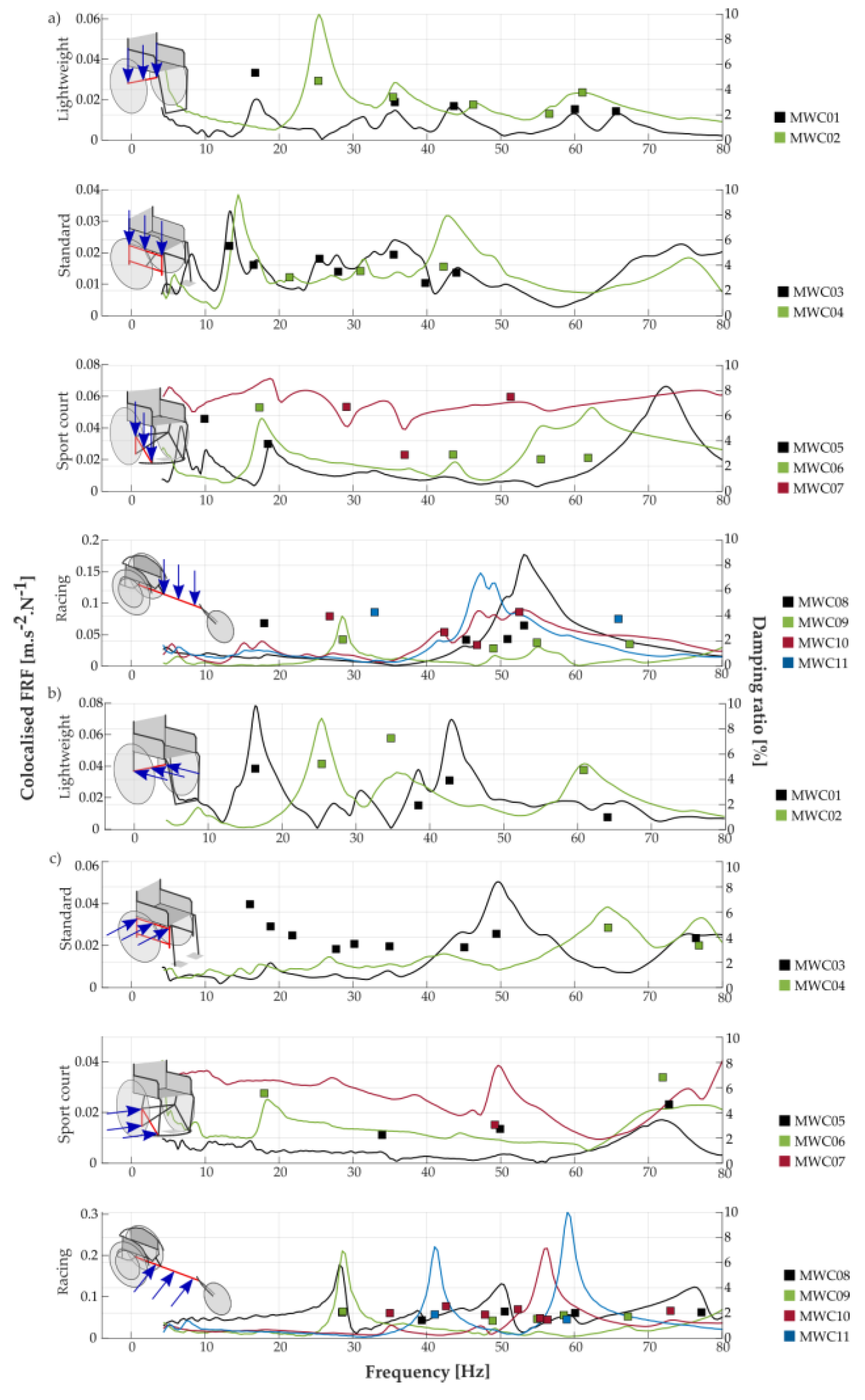
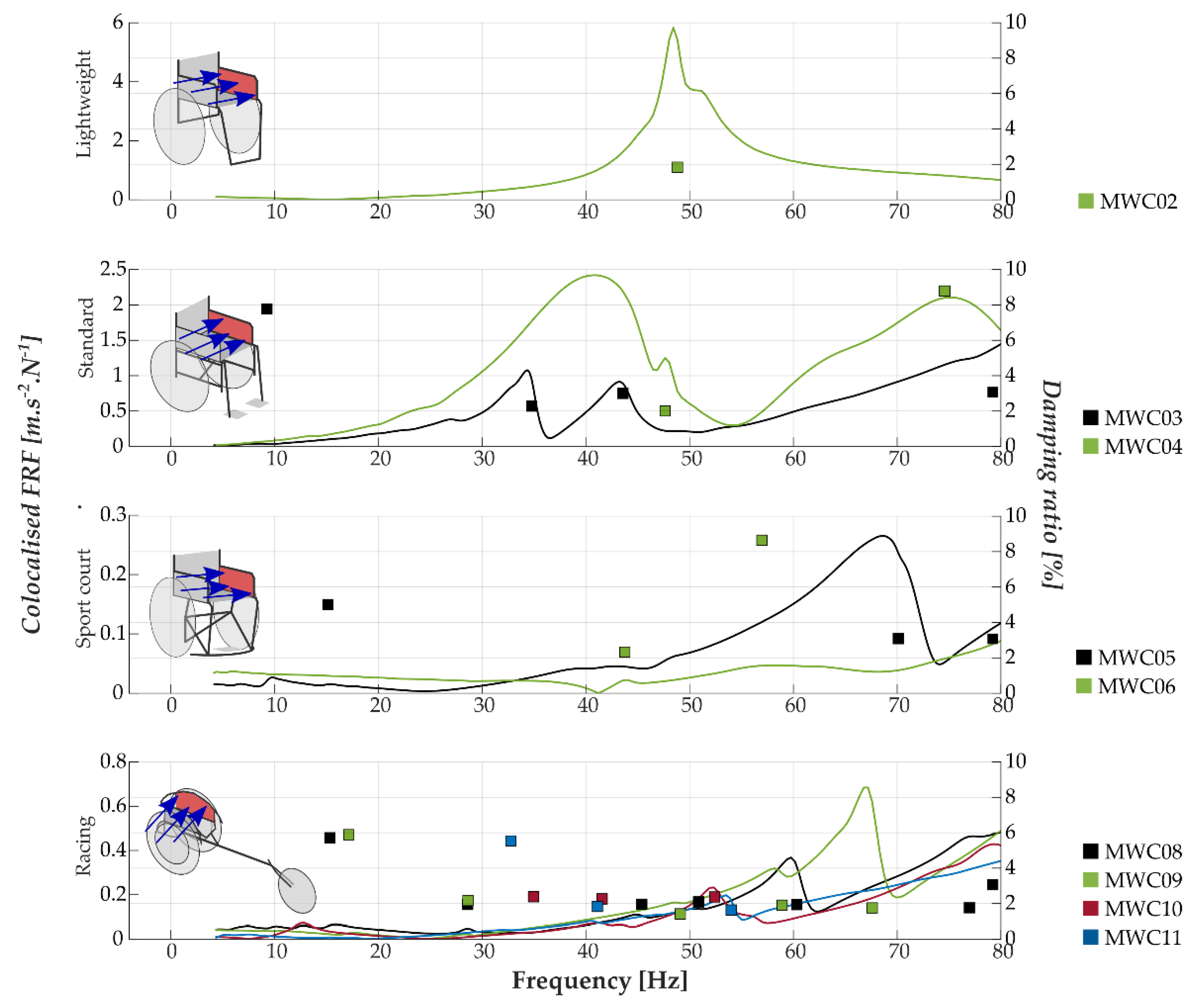

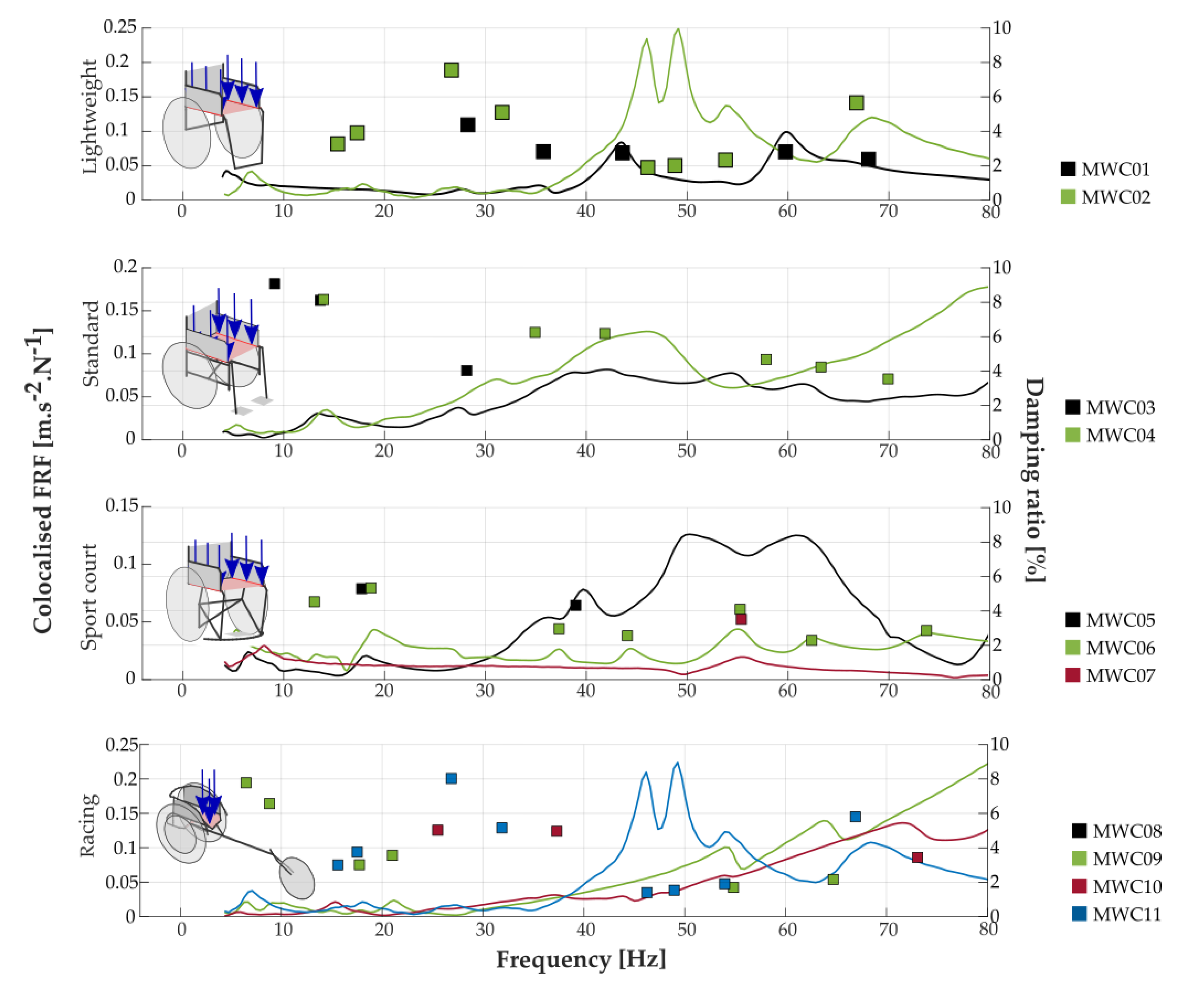
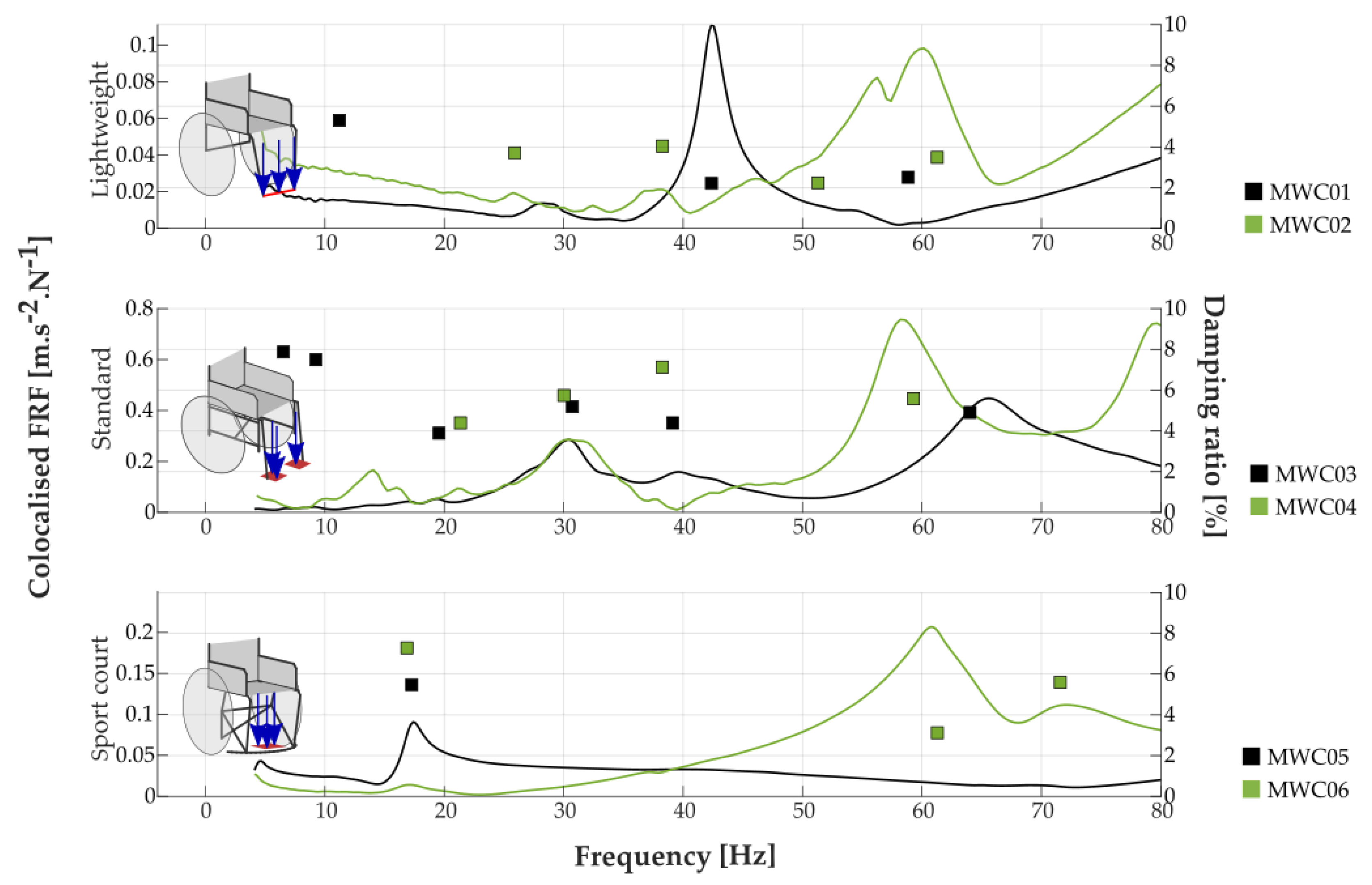
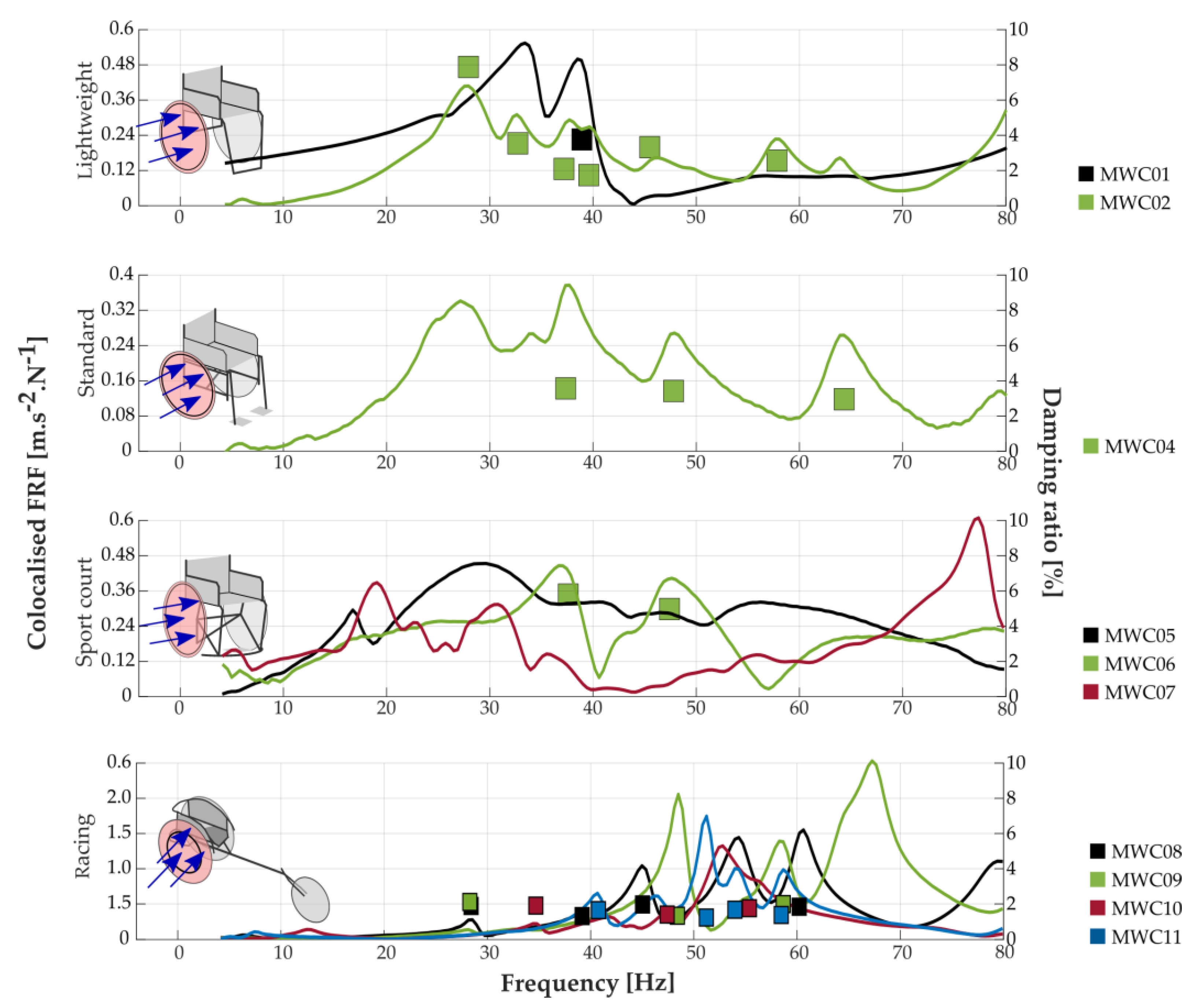
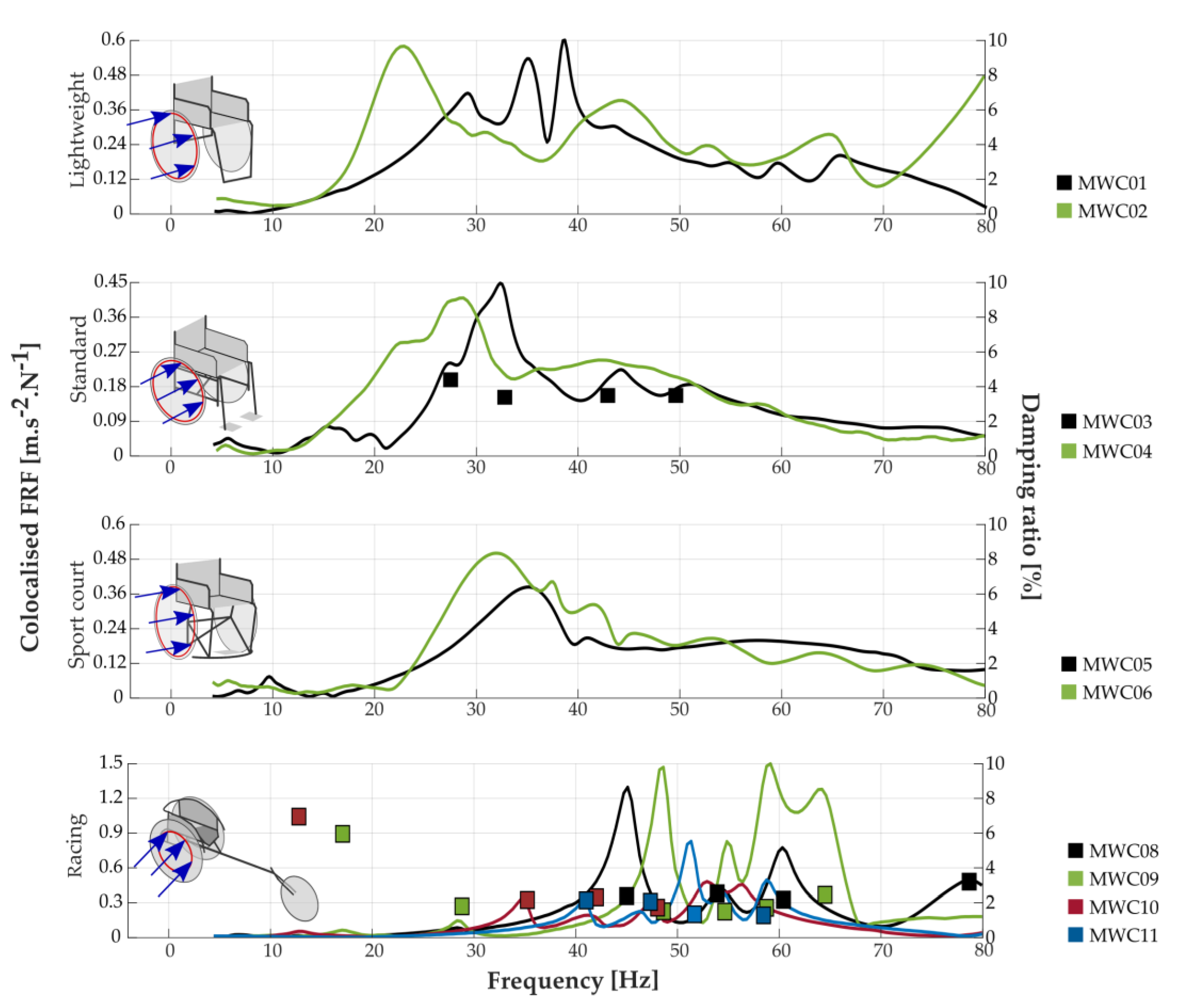

| Type | Daily | Sport | ||||||||||
| Lightweight | Standard | Basketball | Tennis | Racing | ||||||||
 | 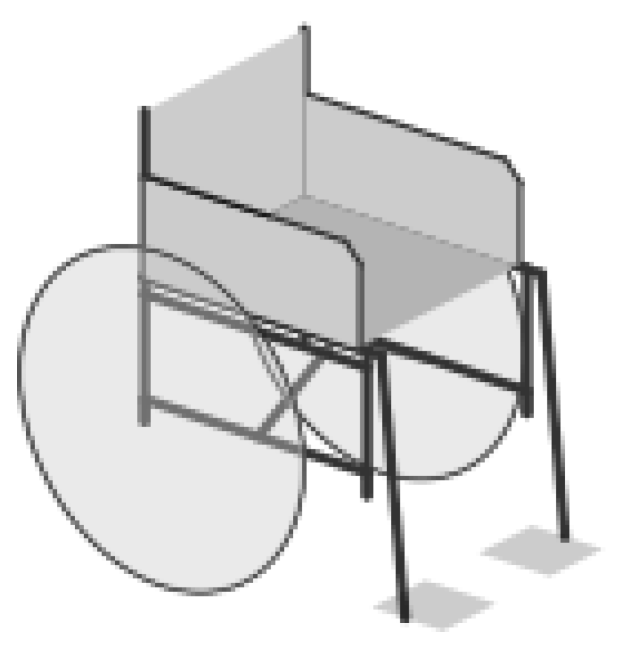 |  | 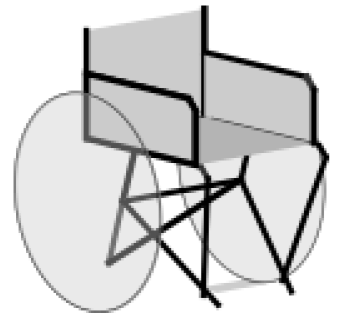 |  | ||||||||
| Name | MWC01 | MWC02 | MWC03 | MWC04 | MWC05 | MWC06 | MWC07 | MWC08 | MWC09 | MWC10 | MWC11 | |
| Model | Ottobock | Invacare | Vermeiren | Vermeiren | Ottobock | Sunrise | Tailor-made manufacturing | Invacare | Invacare | Invacare | Invacare | |
| Voyager Evo | Kuschall KSL | Eclips +30° | D200 | Invader sport | Grand Slam | Top end | Top end | Top end | Top end | |||
| Photo |  |  |  |  | 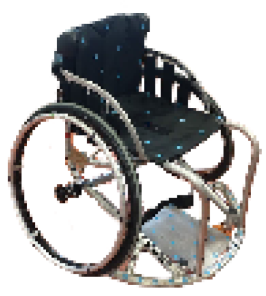 | 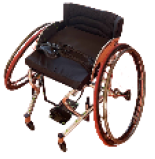 |  | 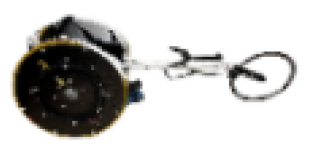 |  |  | 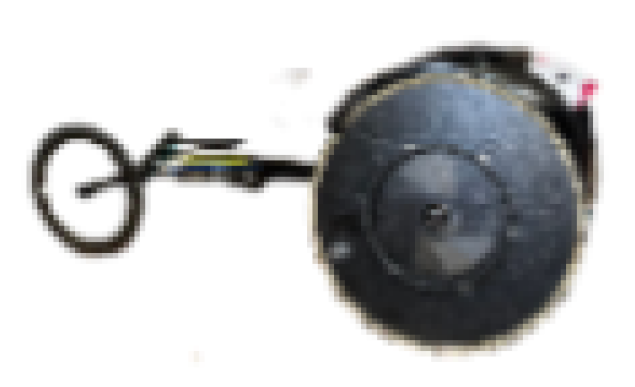 | |
| Folding | x | x | ||||||||||
| Frame material | Al | Al | Al | Al | Al | Al | C | Al | Al | C | C | |
| Masse [kg] | 12 | 9 | 19 | 17 | 12 | 10 | 11 | 10 | 9 | 9 | 8 | |
| Moment of inertia [kg.m²] | 1 | 1 | 2 | 3 | 1 | 1 | 1 | 2 | 2 | 2 | 2 | |
| Centre of mass [cm] | X (front) | 16 | 11 | 20 | 8 | 9 | 2 | 5 | 29 | 26 | 23 | 22 |
| Y (height) | 31 | 33 | 42 | 32 | 30 | 35 | 26 | 38 | 41 | 42 | 41 | |
| Z (lateral) | 1 | 1 | 0 | 0 | 0 | 0 | −4 | 0 | −1 | 0 | 0 | |
| Configuration | Seat width [cm] | 38 | 37 | 42 | 52 | 34 | 38 | NA | 25 | 22 | 32 | 22 |
| Seat depth [cm] | 39 | 45 | 45 | 43 | 34 | 36 | NA | 38 | 37 | 18 | 9 | |
| Seat front height [cm] | 49 | 48 | 50 | 50 | 50 | 47 | 56 | 44 | 49 | 48 | 53 | |
| Seat back height [cm] | 42 | 41 | 49 | 50 | 45 | 49 | 56 | 46 | 49 | 45 | 56 | |
| Seat advanced [cm] | −8 | −11 | 8 | −4 | −8 | 16 | NA | −7 | −11 | NA | NA | |
| Backrest angle [°] | 8 | 2 | 6 | 17 | 5 | 5 | NA | 25 | 2 | NA | NA | |
| Wheel camber [°] | 4 | 3 | 1 | 1 | 15 | 23 | 20 | 13 | 12 | 11 | 11 | |
| Front wheel radius [cm] | 7 | 6 | 10 | 10 | 4 | 4 | 8 | 24 | 24 | 23 | 23 | |
| Back wheel radius [cm] | 30 | 30 | 31 | 31 | 30 | 32 | 34 | 33 | 33 | 33 | 34 | |
| Handrim radius [cm] | 26 | 26 | 27 | 27 | 27 | 29 | 32 | 20 | 19 | 19 | 17 | |
| Wheel base [cm] | 40 | 41 | 50 | 50 | 38 | 36 | 37 | 131 | 120 | 133 | 129 | |
| Back wheel gap [cm] | 61 | 58 | 65 | 72 | 67 | 77 | 67 | 51 | 51 | 49 | 52 | |
| MWC Part | Frame | Side Guards | Backrest | Seat | Footrest | Rear Wheel | Handrim | ||||
|---|---|---|---|---|---|---|---|---|---|---|---|
| Direction | V | ML | AP | ML | ML | AP | V | V | ML | ML | |
Lightweight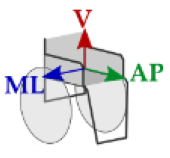 | MWC01 | X | X | X | X | X | X | X | X | ||
| MWC02 | X | X | X | X | X | X | X | X | X | ||
Standard | MWC03 | X | X | X | X | X | X | X | X | ||
| MWC04 | X | X | X | X | X | X | X | X | X | ||
Basketball | MWC07 | X | X | X | X | X | X | X | X | X | |
Tennis | MWC05 | X | X | X | X | X | X | X | X | X | |
| MWC06 | X | X | X | X | X | ||||||
Racing | MWC08 | X | X | X | X | X | |||||
| MWC09 | X | X | X | X | X | X | |||||
| MWC10 | X | X | X | X | X | X | |||||
| MWC11 | X | X | X | X | X | X | |||||
| Lightweight | Standard | Basketball | Tennis | Racing | ||||||||||||||||||||||||||||||
|---|---|---|---|---|---|---|---|---|---|---|---|---|---|---|---|---|---|---|---|---|---|---|---|---|---|---|---|---|---|---|---|---|---|---|
| MWC01 | MWC02 | MWC03 | MWC04 | MWC05 | MWC06 | MWC07 | MWC08 | MWC09 | MWC10 | MWC11 | ||||||||||||||||||||||||
| Fo (Hz) | ξo (%) | Amp | Fo (Hz) | ξo (%) | Amp | Fo (Hz) | ξo (%) | Amp | Fo (Hz) | ξo (%) | Amp | Fo (Hz) | ξo (%) | Amp | Fo (Hz) | ξo (%) | Amp | Fo (Hz) | ξo (%) | Amp | Fo (Hz) | ξo (%) | Amp | Fo (Hz) | ξo (%) | Amp | Fo (Hz) | ξo (%) | Amp | Fo (Hz) | ξo (%) | Amp | ||
| Frame | V | 17 | 5 | 5 × 102 | 25 | 5 | 2 × 102 | 13 | 6 | 3 × 102 | 21 | 3 | 6 × 103 | 10 | 6 | 7 × 102 | 17 | 7 | 2 × 102 | 29 | 7 | 1 × 103 | 18 | 3 | 3 × 103 | 29 | 2 | 3 × 102 | 27 | 4 | 3 × 103 | 33 | 4 | 9 |
| 36 | 3 | 2 × 103 | 35 | 3 | 1 × 103 | 17 | 4 | 3 × 103 | 31 | 4 | 2 × 103 | 18 | 4 | 6 × 102 | 44 | 3 | 2 × 103 | 37 | 3 | 3 × 103 | 45 | 2 | 2 × 103 | 49 | 1 | 2 × 103 | 42 | 3 | 2 × 103 | 66 | 4 | 6 | ||
| 44 | 3 | 2 × 103 | 46 | 3 | 3 × 103 | 25 | 5 | 3 × 103 | 42 | 4 | 8 × 102 | 73 | 4 | 3 × 102 | 55 | 3 | 1 × 103 | 51 | 7 | 8 × 102 | 51 | 2 | 5 × 102 | 55 | 2 | 6 × 102 | 47 | 2 | 1 × 103 | 74 | 3 | 6 | ||
| 60 | 2 | 2 × 103 | 57 | 2 | 2 × 104 | 28 | 3 | 8 × 103 | 62 | 3 | 1 × 103 | 79 | 2 | 6 × 103 | 53 | 3 | 1 × 102 | 53 | 4 | 3 × 102 | ||||||||||||||
| 66 | 2 | 2 × 103 | 61 | 4 | 1 × 104 | 35 | 5 | 1 × 103 | ||||||||||||||||||||||||||
| 40 | 3 | 4 × 103 | ||||||||||||||||||||||||||||||||
| 44 | 3 | 4 × 103 | ||||||||||||||||||||||||||||||||
| 74 | 3 | 4 × 103 | ||||||||||||||||||||||||||||||||
| ML | 16 | 7 | 5 × 103 | 64 | 5 | 6 × 102 | 34 | 2 | 1 × 104 | 18 | 6 | 6 × 102 | 49 | 3 | 8 × 102 | 28 | 2 | 1 × 102 | 29 | 2 | 1 × 102 | 35 | 2 | 1 × 103 | 41 | 2 | 1 × 102 | |||||||
| 19 | 5 | 2 × 103 | 77 | 3 | 7 × 102 | 50 | 3 | 1 × 104 | 72 | 7 | 8 × 103 | 39 | 1 | 1 × 103 | 49 | 1 | 2 × 103 | 43 | 3 | 1 × 104 | 59 | 1 | 1 × 102 | |||||||||||
| 22 | 4 | 2 × 105 | 73 | 5 | 8 × 102 | 51 | 2 | 2 × 102 | 55 | 2 | 3 × 103 | 48 | 2 | 6 × 103 | ||||||||||||||||||||
| 28 | 3 | 1 × 104 | 60 | 2 | 9 × 102 | 58 | 2 | 1 × 104 | 52 | 2 | 1 × 103 | |||||||||||||||||||||||
| 30 | 3 | 2 × 104 | 77 | 2 | 3 × 102 | 67 | 2 | 2 × 103 | 55 | 2 | 7 × 102 | |||||||||||||||||||||||
| 35 | 3 | 4 × 103 | 56 | 1 | 5 × 102 | |||||||||||||||||||||||||||||
| 45 | 3 | 3 × 103 | 73 | 2 | 2 × 103 | |||||||||||||||||||||||||||||
| 49 | 4 | 3 × 102 | ||||||||||||||||||||||||||||||||
| 76 | 4 | 1 × 103 | ||||||||||||||||||||||||||||||||
| AP | 16 | 5 | 1 × 102 | 25 | 5 | 1 × 102 | ||||||||||||||||||||||||||||
| 38 | 2 | 1 × 103 | 35 | 7 | 7 × 102 | |||||||||||||||||||||||||||||
| 43 | 4 | 2 × 102 | 61 | 5 | 3 × 102 | |||||||||||||||||||||||||||||
| 64 | 1 | 2 × 104 | ||||||||||||||||||||||||||||||||
| Side guard | ML | 49 | 2 | 7 | 9 | 8 | 7 × 102 | 48 | 2 | 9 | 15 | 5 | 3 × 103 | 44 | 2 | 1 × 103 | 15 | 6 | 6 × 102 | 17 | 6 | 6 × 102 | 35 | 2 | 9 × 103 | 33 | 6 | 1 × 103 | ||||||
| 35 | 2 | 5 × 10 | 75 | 9 | 4 | 70 | 3 | 1 × 102 | 57 | 9 | 4 × 102 | 29 | 2 | 1 × 103 | 29 | 2 | 2 × 103 | 42 | 2 | 2 × 103 | 41 | 2 | 2 × 103 | |||||||||||
| 44 | 3 | 3 × 10 | 45 | 2 | 1 × 103 | 49 | 1 | 2 × 103 | 52 | 2 | 1 × 102 | 54 | 2 | 2 × 102 | ||||||||||||||||||||
| 51 | 2 | 2 × 103 | 59 | 2 | 4 × 102 | |||||||||||||||||||||||||||||
| 60 | 2 | 1 × 102 | 68 | 2 | 6 × 10 | |||||||||||||||||||||||||||||
| 77 | 2 | 8 × 102 | ||||||||||||||||||||||||||||||||
| Backrest | ML | 36 | 3 | 3 × 102 | 44 | 7 | 8 × 101 | 16 | 7 | 1 × 104 | 14 | 12 | 2 × 102 | 49 | 3 | 2 × 103 | 19 | 7 | 2 × 103 | |||||||||||||||
| 39 | 2 | 4 × 102 | 51 | 3 | 5 × 102 | 21 | 7 | 1 × 105 | 31 | 7 | 1 × 102 | 72 | 5 | 2 × 102 | ||||||||||||||||||||
| 42 | 2 | 1 × 103 | 27 | 4 | 8 × 102 | |||||||||||||||||||||||||||||
| 55 | 4 | 4 × 102 | 36 | 4 | 1 × 103 | |||||||||||||||||||||||||||||
| 66 | 3 | 2 × 102 | 54 | 5 | 1 × 102 | |||||||||||||||||||||||||||||
| AP | 37 | 2 | 5 × 102 | 27 | 7 | 3 × 102 | 27 | 4 | 6 × 103 | 8 | 6 | 4 × 103 | 57 | 11 | 3 | |||||||||||||||||||
| 39 | 2 | 3 × 102 | 38 | 3 | 7 × 102 | 34 | 3 | 5 × 103 | 10 | 5 | 2 × 103 | |||||||||||||||||||||||
| 55 | 2 | 2 × 104 | 46 | 4 | 8 × 10 | 70 | 3 | 3 × 102 | 16 | 6 | 2 × 102 | |||||||||||||||||||||||
| 66 | 3 | 5 × 102 | 52 | 4 | 9 × 10 | 21 | 5 | 1 × 102 | ||||||||||||||||||||||||||
| 33 | 6 | 3 × 102 | ||||||||||||||||||||||||||||||||
| 41 | 4 | 1 × 103 | ||||||||||||||||||||||||||||||||
| 57 | 4 | 4 × 103 | ||||||||||||||||||||||||||||||||
| Seat | V | 28 | 4 | 3 × 103 | 26 | 5 | 4 × 102 | 9 | 9 | 2 × 102 | 14 | 8 | 2 × 102 | 18 | 5 | 2 × 103 | 13 | 4 | 2 × 103 | 56 | 3 | 2 × 103 | 9 | 7 | 8 × 102 | 25 | 5 | 16 | 3 | 4 × 103 | ||||
| 36 | 3 | 8 × 103 | 39 | 2 | 2 × 103 | 14 | 8 | 2 × 103 | 35 | 6 | 8 × 102 | 39 | 4 | 1 × 102 | 19 | 5 | 7 × 102 | 18 | 3 | 3 × 103 | 37 | 5 | 17 | 4 | 2 × 103 | |||||||||
| 44 | 2 | 7 × 102 | 42 | 3 | 9 × 102 | 28 | 4 | 1 × 103 | 42 | 6 | 2 × 103 | 37 | 3 | 5 × 103 | 21 | 4 | 8 × 102 | 73 | 3 | 27 | 8 | 4 × 102 | ||||||||||||
| 60 | 2 | 4 × 102 | 47 | 5 | 3 × 102 | 58 | 5 | 8 × 103 | 44 | 2 | 1 × 103 | 55 | 2 | 7 × 102 | 32 | 5 | 4 × 103 | |||||||||||||||||
| 68 | 2 | 9 × 103 | 51 | 3 | 9 × 102 | 63 | 4 | 3 × 103 | 55 | 4 | 7 × 102 | 65 | 2 | 6 × 102 | 46 | 1 | 3 × 102 | |||||||||||||||||
| 66 | 3 | 6 × 103 | 70 | 3 | 3 × 103 | 63 | 2 | 2 × 103 | 49 | 2 | 3 × 102 | |||||||||||||||||||||||
| 74 | 3 | 2 × 103 | 54 | 2 | 1 × 103 | |||||||||||||||||||||||||||||
| 67 | 6 | 9 × 10 | ||||||||||||||||||||||||||||||||
| Footrest | V | 11 | 5 | 4 × 104 | 26 | 4 | 3 × 103 | 9 | 7 | 1 × 103 | 21 | 4 | 4 × 102 | 17 | 5 | 1 × 102 | ||||||||||||||||||
| 42 | 2 | 2 × 102 | 38 | 4 | 1 × 103 | 20 | 4 | 6 × 102 | 30 | 6 | 1 × 102 | |||||||||||||||||||||||
| 59 | 3 | 9 × 103 | 51 | 2 | 5 × 107 | 31 | 5 | 7 × 10 | 38 | 7 | 9 × 102 | |||||||||||||||||||||||
| 61 | 3 | 3 × 102 | 39 | 4 | 2 × 102 | 59 | 6 | 1 × 10 | ||||||||||||||||||||||||||
| 64 | 5 | 5 × 10 | 80 | 3 | 4 × 10 | |||||||||||||||||||||||||||||
| Wheel | ML | 39 | 3 | 2 × 102 | 28 | 8 | 3 × 10 | 37 | 4 | 2 × 102 | 51 | 3 | 1 × 103 | 38 | 6 | 5 × 10 | 29 | 2 | 1 × 102 | 28 | 2 | 3 × 102 | 13 | 8 | 1 × 102 | 41 | 2 | 6 × 10 | ||||||
| 32 | 4 | 8 × 10 | 47 | 3 | 1 × 102 | 46 | 4 | 1 × 102 | 39 | 1 | 3 × 102 | 33 | 5 | 4 × 102 | 35 | 2 | 2 × 102 | 51 | 1 | 3 × 10 | ||||||||||||||
| 37 | 2 | 3 × 102 | 64 | 2 | 1 × 102 | 45 | 2 | 3 × 10 | 49 | 1 | 2 × 10 | 42 | 2 | 2 × 102 | 54 | 2 | 6 × 10 | |||||||||||||||||
| 39 | 2 | 7 × 102 | 79 | 2 | 8 × 102 | 54 | 3 | 2 × 10 | 59 | 2 | 2 × 10 | 48 | 2 | 1 × 102 | 59 | 2 | 7 × 10 | |||||||||||||||||
| 45 | 3 | 3 × 102 | 60 | 2 | 2 × 10 | 65 | 4 | 1 × 10 | 52 | 2 | 2 × 10 | |||||||||||||||||||||||
| 57 | 3 | 1 × 102 | 79 | 3 | 2 × 10 | 67 | 2 | 1 × 10 | 55 | 2 | 2 × 102 | |||||||||||||||||||||||
| 82 | 2 | 6 × 10 | ||||||||||||||||||||||||||||||||
| Handrim | ML | 27 | 4 | 2 × 102 | 29 | 2 | 7 × 102 | 17 | 5 | 2 × 102 | 13 | 8 | 1 × 102 | 41 | 2 | 2 × 104 | ||||||||||||||||||
| 33 | 3 | 3 × 102 | 45 | 2 | 2 × 10 | 29 | 2 | 3 × 102 | 35 | 2 | 2 × 102 | 47 | 2 | 9 × 104 | ||||||||||||||||||||
| 43 | 4 | 2 × 102 | 54 | 3 | 5 × 10 | 48 | 1 | 1 × 10 | 42 | 3 | 2 × 102 | 51 | 1 | 2 × 104 | ||||||||||||||||||||
| 49 | 4 | 3 × 102 | 60 | 2 | 4 × 10 | 55 | 2 | 3 × 102 | 48 | 2 | 1 × 102 | 59 | 2 | 2 × 104 | ||||||||||||||||||||
| 79 | 3 | 1 × 102 | 59 | 2 | 7 × 10 | |||||||||||||||||||||||||||||
| 64 | 2 | 1 × 102 | ||||||||||||||||||||||||||||||||
| 67 | 2 | 4 × 10 | ||||||||||||||||||||||||||||||||
Publisher’s Note: MDPI stays neutral with regard to jurisdictional claims in published maps and institutional affiliations. |
© 2022 by the authors. Licensee MDPI, Basel, Switzerland. This article is an open access article distributed under the terms and conditions of the Creative Commons Attribution (CC BY) license (https://creativecommons.org/licenses/by/4.0/).
Share and Cite
Lariviere, O.; Chadefaux, D.; Sauret, C.; Kordulas, L.; Thoreux, P. Modal Characterization of Manual Wheelchairs. Vibration 2022, 5, 442-463. https://doi.org/10.3390/vibration5030025
Lariviere O, Chadefaux D, Sauret C, Kordulas L, Thoreux P. Modal Characterization of Manual Wheelchairs. Vibration. 2022; 5(3):442-463. https://doi.org/10.3390/vibration5030025
Chicago/Turabian StyleLariviere, Ophélie, Delphine Chadefaux, Christophe Sauret, Layla Kordulas, and Patricia Thoreux. 2022. "Modal Characterization of Manual Wheelchairs" Vibration 5, no. 3: 442-463. https://doi.org/10.3390/vibration5030025
APA StyleLariviere, O., Chadefaux, D., Sauret, C., Kordulas, L., & Thoreux, P. (2022). Modal Characterization of Manual Wheelchairs. Vibration, 5(3), 442-463. https://doi.org/10.3390/vibration5030025






